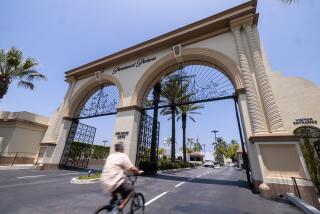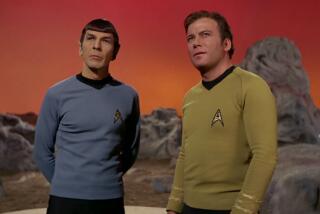For Sale: The Final Frontier
- Share via
On Sept. 8, 1966, NBC aired the premiere of an underfunded, overachieving science fiction series set in the 23rd century and called “Star Trek.” It was the Big Bang.
After a brief period of cosmological inflation -- the show was on for three years before being canceled, despite a loyal viewership -- the Star Trek universe cooled, expanding at a much reduced rate.
There were the first proto-conventions of trekkies, gatherings of the unmarried and the pointy-eared, and an animated series. Meanwhile, the reruns were faring well in syndication. But beyond that it didn’t seem as if anything more substantial was going to come of the series.
Then “Star Wars” appeared in 1977, and Paramount Pictures, which was considering a TV remounting of the series, decided to answer with the big screen “Star Trek: The Motion Picture.” Creator Gene Roddenberry, who had been reduced to the college lecture circuit, managed to reassemble the original cast, and in 1979 the good ship “Enterprise” warped into action again.
Well, you know the rest of the story. Or perhaps not. “Star Trek” is the most successful entertainment franchise in history. Think of that. Roddenberry’s middle-brow paean to human potential spawned four more “Star Trek” TV series as well as 10 motion pictures, a catalog that has brought Paramount billions.
If you do a search on Amazon.com for “Star Trek”-themed books, you’ll get a list of more than 15,000 titles. Not to mention the video games, animated series, the fanzines and the conventions.
Add it all up and you realize that “Star Trek” -- the horn-rimmed invention of an eccentric Hollywood scriptwriter--is one of the two or three richest, most thoroughly elaborated fictional narratives in human history.
What comes close? The Vedas, perhaps. The Bible?
In terms of the number of characters, story lines, the comings and goings of civilizations, the Bible is not even in the same ballpark, or quadrant of the galaxy, as they say on the bridge of the Enterprise.
And now you can buy the bridge of the Enterprise. Just in time for the 40th anniversary, Paramount has commissioned Christie’s to auction hundreds of items from its warehouse -- props, sets, costumes and assorted space debris from the TV series and movies. The sale will take place this week in New York.
This event is, I think, unprecedented: When has a mythological universe ever been liquidated? It’s as if Mt. Olympus had a yard sale. How much for Artemis’ bow?
I visited the preview showing at Christie’s in Beverly Hills recently and dipped my toe in those crazy waters. Among the exhibits was Captain Kirk’s dress uniform from “Star Trek II: The Wrath of Khan,” estimated to sell for $6,000 to $8,000.
Also on display was one of the cat suits that actress Jeri Ryan wore as the bodacious Borg Seven of Nine on “Star Trek: Voyager.” I shudder to think what that will go for (“Come on, honey, put it on, just tonight. I bought it for us!”).
Phaser guns and tricorders and Worf’s ceremonial baldric (if you don’t know what a Worf or a baldric is, that’s OK). Who wouldn’t like a Klingon cloaking device?
The last lot to be sold is an 8-foot-long “hero” model of “Enterprise 1701-A” -- it’s estimated this item will go for five figures. I personally would love to have it hanging in my garage.
It would be nice to report that Paramount is donating the proceeds to charity. It isn’t. One of the ironies of “Star Trek” is that Roddenberry’s dream of a money-less future is merchandized to within an inch of a Ferengi’s life. A Ferengi is ... well, never mind.
Paramount’s housecleaning is both literal and figurative. The studio plans to make an 11th film, produced by J.J. Abrams, to be released in 2008. Set phasers to milk! Early word is it will be something of a “reboot,” a la “Batman Begins.” There was a widespread rumor, since discounted, that Matt Damon would be cast as a young Captain Kirk at Starfleet Academy.
The reboot is becoming a Hollywood art form all its own, as the film industry attempts to breathe new life into fading franchises. But what would a reboot of “Star Trek” be like?
In the world of “Star Trek” fandom there is what’s called the “canon” -- the official, Paramount-approved narrative, with internally consistent timeline, characters, aliens and alliances. To depart from any of that would be to invite geek insurrection. To revisit it is to court blasphemy. That’s all we need: Owen Wilson as Dr. Leonard McCoy.
So, my proposal: Leave it all behind. Set the clock running in the 30th century. In other words, “Star Trek: The New Testament.” If Roddenberry’s creation was about anything, it was about human evolution.
So, keepers of the “Star Trek” legacy, where will you take us next? More trade wars with Cardassians and tribulations with Romulans? The universe is expanding. Why would Star Trek’s world be getting smaller? The only continuity need be the name Enterprise, which still sounds grand in its ambition.
Forty years on, the greatest tribute to Roddenberry’s legacy would be to abandon it.
Dan Neil’s column appears in West Magazine in the Sunday Final edition.
More to Read
The biggest entertainment stories
Get our big stories about Hollywood, film, television, music, arts, culture and more right in your inbox as soon as they publish.
You may occasionally receive promotional content from the Los Angeles Times.










